
Roger I, nicknamed “Roger Bosso” and “Grand Count Roger”, was a Norman nobleman who became the first Grand Count of Sicily from 1071 to 1101.
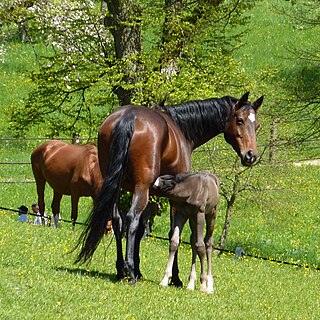
The Württemberger, Baden-Württemberger or Württemberg is a Warmblood horse breed originating in Germany. They are primarily riding horses, and are selectively bred for dressage and show jumping.
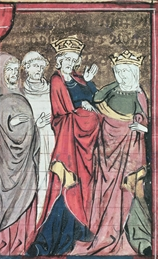
Adelaide del Vasto was countess of Sicily as the third spouse of Roger I of Sicily, and Queen consort of Jerusalem by marriage to Baldwin I of Jerusalem. She served as regent of Sicily during the minority of her son Roger II of Sicily from 1101 until 1112.

The Budyonny is a breed of horse from Russia. It was bred as a military horse after the Russian Revolution of 1917; in the twenty-first century it is used as an all-purpose competition horse and for driving.
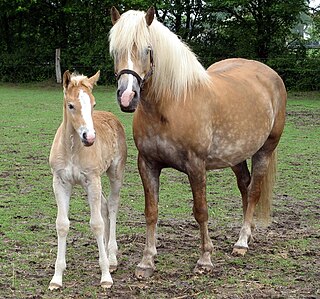
The Haflinger, also known as the Avelignese, is a breed of horse developed in Austria and northern Italy during the late 19th century. Haflinger horses are relatively small, are always chestnut with flaxen mane and tail, have distinctive gaits described as energetic but smooth, and are well-muscled yet elegant. The breed traces its ancestry to the Middle Ages; several theories for its origin exist. Haflingers, developed for use in mountainous terrain, are known for their hardiness. Their current conformation and appearance are the result of infusions of bloodlines from Arabian and various European breeds into the original native Tyrolean ponies. The foundation sire, 249 Folie, was born in 1874; by 1904, the first breeders' cooperative was formed. All Haflingers can trace their lineage back to Folie through one of seven bloodlines. World Wars I and II, as well as the Great Depression, had a detrimental effect on the breed, and lower-quality animals were used at times to save the breed from extinction. During World War II, breeders focused on horses that were shorter and more draft-like, favored by the military for use as packhorses. The emphasis after the war shifted toward animals of increased refinement and height.

The Boulonnais, also known as the "White Marble Horse", is a draft horse breed. It is known for its large but elegant appearance and is usually gray, although chestnut and black are also allowed by the French breed registry. Originally there were several sub-types, but they were crossbred until only one is seen today. The breed's origins trace to a period before the Crusades and, during the 17th century, Spanish Barb, Arabian, and Andalusian blood were added to create the modern type.

The Murgese is an Italian breed of riding horse. It is named for its area of origin, the plateau of Le Murge in southern Italy, most of which lies in the region of Puglia. It was formerly used as an agricultural or military horse; selection for a lighter type more suitable for riding began in the second half of the twentieth century.
The Peneia Pony is a rare breed of pony from the Peloponnese in southern Greece, originating in the former prefecture of Elis, which included the village of Peneia (Pineia).

San Fratello, formerly San Filadelfo, is a comune (municipality) in the Metropolitan City of Messina in the Italian region Sicily, located about 110 kilometres (68 mi) east of Palermo and about 90 kilometres (56 mi) west of Messina. San Fratello borders the following municipalities: Acquedolci, Alcara li Fusi, Caronia, Cesarò, Militello Rosmarino, Sant'Agata di Militello.
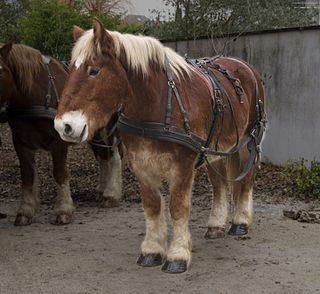
The Trait Breton is a French breed of draught horse. It originated in Brittany, in north-west France, from cross-breeding of local horses with various other breeds. It is strong and muscular, and often has a chestnut coat.
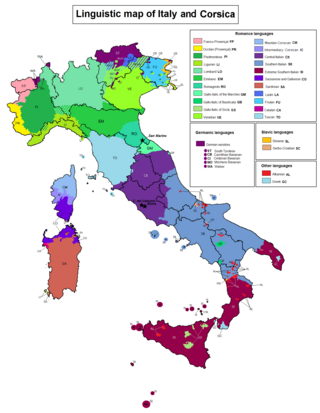
Gallo-Italic of Sicily is a group of Gallo-Italic languages found in about 15 isolated communities of central eastern Sicily. Forming a language island in the otherwise Sicilian language area, it dates back to migrations from northern Italy during the reign of Norman Roger I of Sicily and his successors.
The Lokai, a mountain horse bred in Tajikistan, is used as a riding horse, a packhorse, or even sometimes a light draft horse. Although small, the breed is agile and hardy. The breed was developed by crossing native mountain horses with a mixture of Central Asian and European bloodlines.

The Sardinian Anglo-Arab or Anglo-Arabo Sardo is an Italian breed of riding horse from the Mediterranean island of Sardinia. It derives from cross-breeding of local mares with stallions of Arab, Anglo-Arab and Thoroughbred stock. Breeding began in 1874; the breed was officially recognised in 1967.

The Bardigiano is a breed of small horse from the Emilia Romagna region of Italy. It takes its name from the town of Bardi, in the Apennines of Parma, and is principally associated with the surrounding area and the Valle del Ceno. The mountain environment and steep, rough terrain of the area have contributed to produce a robust, hardy breed, agile and sure-footed over difficult ground. Although some males and all females are under 14.2 hands, the Bardigiano is always considered a horse in its home country. The stud book was established in 1977, and is held by the Associazione Provinciale Allevatori, the regional animal breeders' association, of Parma. The breed is widely distributed in Italy, with breeders in 26 Italian provinces; a recent study examined 3556 stud book entries for living horses. Due to these relatively large numbers, the breed is not considered to be at risk of extinction, but is classed as "vulnerable".

The heavy warmbloods are a group of horse breeds primarily from continental Europe. The title includes the Ostfriesen and Alt-Oldenburger ("Old-Oldenburger"), Groningen, and similar horses from Silesia, Saxony-Thuringia, and Bavaria. Breeds like the Hungarian Nonius, Kladruber, and Cleveland Bay are also often classed as "heavy warmbloods." They are the ancestors of the modern warmbloods, and are typically bred by preservation groups to fit the pre-World War I model of the all-purpose utility horse. Unlike the registries of the sport horses that followed them, many heavy warmblood registries maintain closed or partly closed studbooks. However, external evaluation and performance testing of the breeding stock is still a key element in these registries. Many of the heavy warmbloods are selected primarily for family-friendly temperaments.

The Lombards of Sicily are an ethnolinguistic minority living in Sicily, southern Italy, speaking an isolated variety of Gallo-Italic languages, the so-called Gallo-Italic of Sicily.

A part-Arabian, partbred Arabian or, less precisely, half-Arabian, is a horse with documented amounts of Arabian horse breeding but not a purebred. Because the Arabian is deemed to be a breed of purebred horse dating back many centuries, the modern breed registries recognized by the World Arabian Horse Organization generally have tightly closed stud books which exclude a horse from registration if it is found to contain any outside blood. However, Arabian breeding has also been used for centuries to add useful traits to countless other horse breeds. In the modern era, crossbreeding has been popular to combine the best traits of two different breeds, such as color, size, or ability to specialize in a particular equestrian discipline.

Eremburga of Mortain was the second wife of Count Roger I of Sicily and thus the second Sicilian countess. She is very obscure and details of her life are almost unknown to us today.
The Chernomor is a Russian breed of saddle horse originating from the Krasnodar Krai and Rostov Oblast, near the Black Sea in Russia. The Chernomor was originally bred from crosses between the mounts of Zaporozhian Cossacks and Kazakh nomads in the late 18th century. The breed was then influenced by crosses with various saddle horses, such as the Russian Don and the Karabakh. After the World War I, Chernomor breeding was weakened and merged with that of the Budyonny breed.















